Consumer Behavior Analysis: Ritz Hotel's Marketing and Decision-Making
VerifiedAdded on 2023/01/05
|13
|3260
|65
Report
AI Summary
This report provides a comprehensive analysis of consumer behavior within the context of The Ritz Hotel, a renowned five-star establishment in London. It delves into the critical importance of understanding consumer decision-making journeys, mapping the five stages of awareness, information search, evaluation, commitment, and support. The report highlights the significance of mapping these journeys to attract customers and run effective marketing campaigns. It explores the differences between B2C and B2B decision-making processes, illustrating how The Ritz Hotel adapts its strategies to cater to individual customers and corporate clients. Furthermore, the report examines various market research approaches, including primary and secondary research methods, and demonstrates how marketers can influence different stages of the hospitality decision-making process. It also references Maslow's motivation-need theory. The analysis provides valuable insights into how The Ritz Hotel can refine its marketing strategies and enhance customer satisfaction.
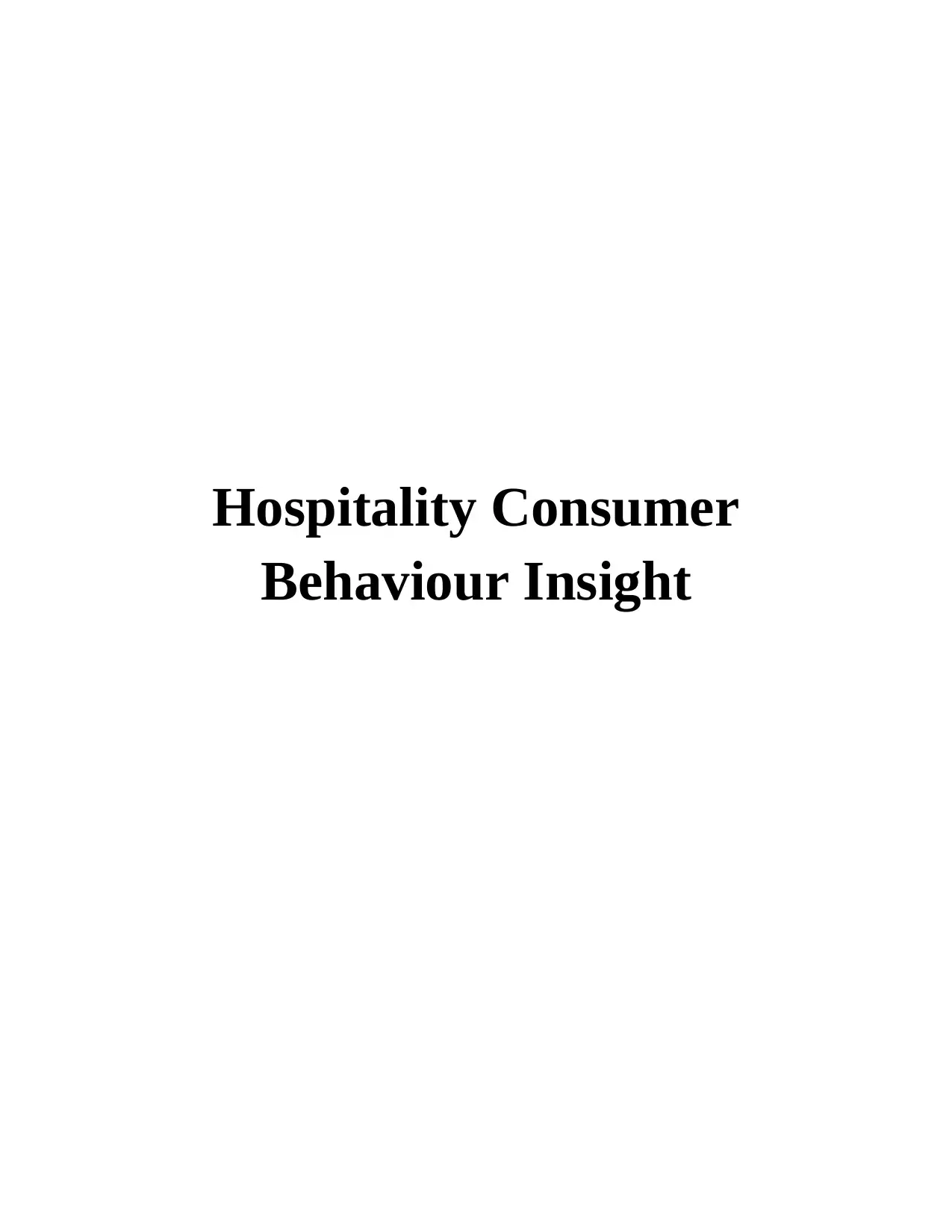
Hospitality Consumer
Behaviour Insight
Behaviour Insight
Paraphrase This Document
Need a fresh take? Get an instant paraphrase of this document with our AI Paraphraser
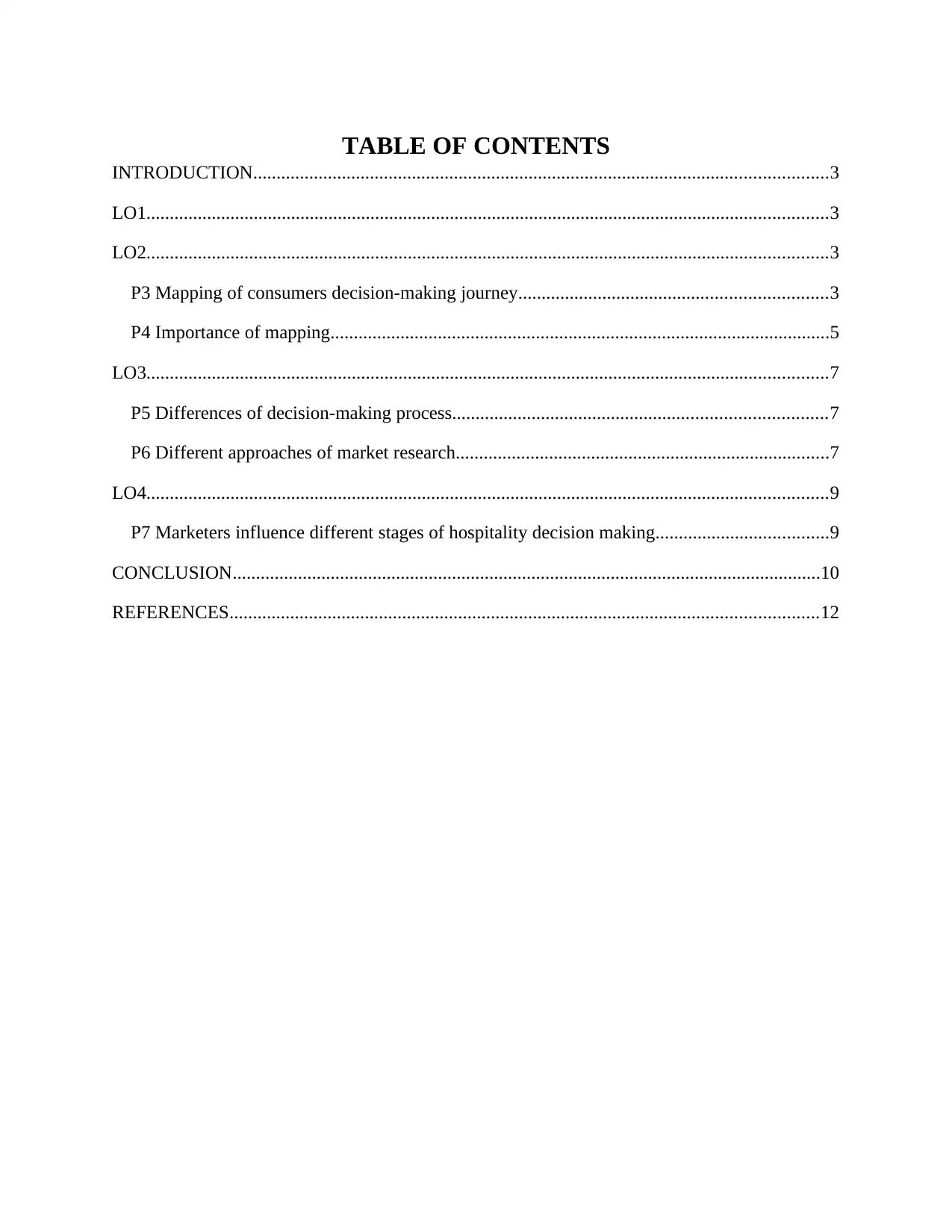
TABLE OF CONTENTS
INTRODUCTION...........................................................................................................................3
LO1..................................................................................................................................................3
LO2..................................................................................................................................................3
P3 Mapping of consumers decision-making journey..................................................................3
P4 Importance of mapping...........................................................................................................5
LO3..................................................................................................................................................7
P5 Differences of decision-making process................................................................................7
P6 Different approaches of market research................................................................................7
LO4..................................................................................................................................................9
P7 Marketers influence different stages of hospitality decision making.....................................9
CONCLUSION..............................................................................................................................10
REFERENCES..............................................................................................................................12
INTRODUCTION...........................................................................................................................3
LO1..................................................................................................................................................3
LO2..................................................................................................................................................3
P3 Mapping of consumers decision-making journey..................................................................3
P4 Importance of mapping...........................................................................................................5
LO3..................................................................................................................................................7
P5 Differences of decision-making process................................................................................7
P6 Different approaches of market research................................................................................7
LO4..................................................................................................................................................9
P7 Marketers influence different stages of hospitality decision making.....................................9
CONCLUSION..............................................................................................................................10
REFERENCES..............................................................................................................................12
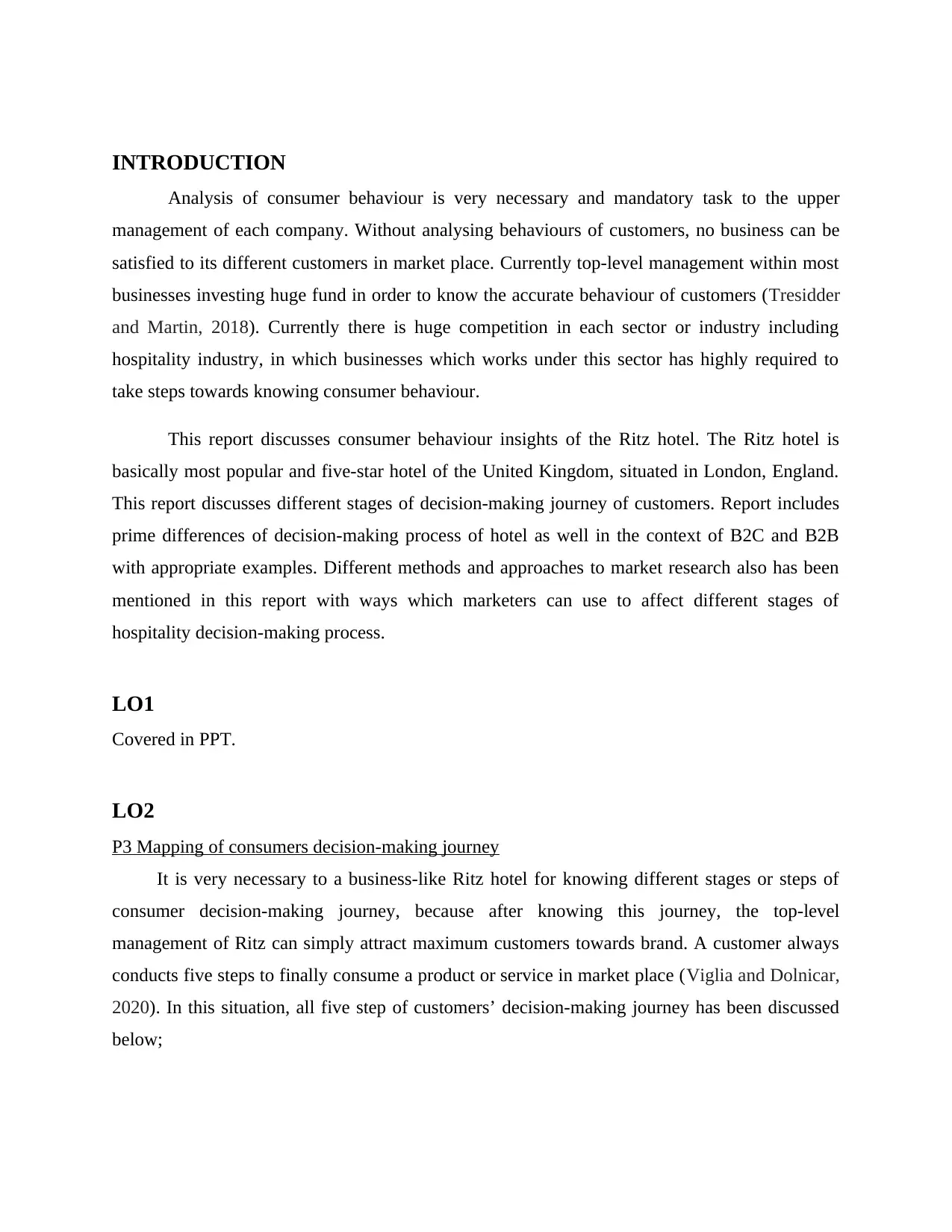
INTRODUCTION
Analysis of consumer behaviour is very necessary and mandatory task to the upper
management of each company. Without analysing behaviours of customers, no business can be
satisfied to its different customers in market place. Currently top-level management within most
businesses investing huge fund in order to know the accurate behaviour of customers (Tresidder
and Martin, 2018). Currently there is huge competition in each sector or industry including
hospitality industry, in which businesses which works under this sector has highly required to
take steps towards knowing consumer behaviour.
This report discusses consumer behaviour insights of the Ritz hotel. The Ritz hotel is
basically most popular and five-star hotel of the United Kingdom, situated in London, England.
This report discusses different stages of decision-making journey of customers. Report includes
prime differences of decision-making process of hotel as well in the context of B2C and B2B
with appropriate examples. Different methods and approaches to market research also has been
mentioned in this report with ways which marketers can use to affect different stages of
hospitality decision-making process.
LO1
Covered in PPT.
LO2
P3 Mapping of consumers decision-making journey
It is very necessary to a business-like Ritz hotel for knowing different stages or steps of
consumer decision-making journey, because after knowing this journey, the top-level
management of Ritz can simply attract maximum customers towards brand. A customer always
conducts five steps to finally consume a product or service in market place (Viglia and Dolnicar,
2020). In this situation, all five step of customers’ decision-making journey has been discussed
below;
Analysis of consumer behaviour is very necessary and mandatory task to the upper
management of each company. Without analysing behaviours of customers, no business can be
satisfied to its different customers in market place. Currently top-level management within most
businesses investing huge fund in order to know the accurate behaviour of customers (Tresidder
and Martin, 2018). Currently there is huge competition in each sector or industry including
hospitality industry, in which businesses which works under this sector has highly required to
take steps towards knowing consumer behaviour.
This report discusses consumer behaviour insights of the Ritz hotel. The Ritz hotel is
basically most popular and five-star hotel of the United Kingdom, situated in London, England.
This report discusses different stages of decision-making journey of customers. Report includes
prime differences of decision-making process of hotel as well in the context of B2C and B2B
with appropriate examples. Different methods and approaches to market research also has been
mentioned in this report with ways which marketers can use to affect different stages of
hospitality decision-making process.
LO1
Covered in PPT.
LO2
P3 Mapping of consumers decision-making journey
It is very necessary to a business-like Ritz hotel for knowing different stages or steps of
consumer decision-making journey, because after knowing this journey, the top-level
management of Ritz can simply attract maximum customers towards brand. A customer always
conducts five steps to finally consume a product or service in market place (Viglia and Dolnicar,
2020). In this situation, all five step of customers’ decision-making journey has been discussed
below;
⊘ This is a preview!⊘
Do you want full access?
Subscribe today to unlock all pages.

Trusted by 1+ million students worldwide
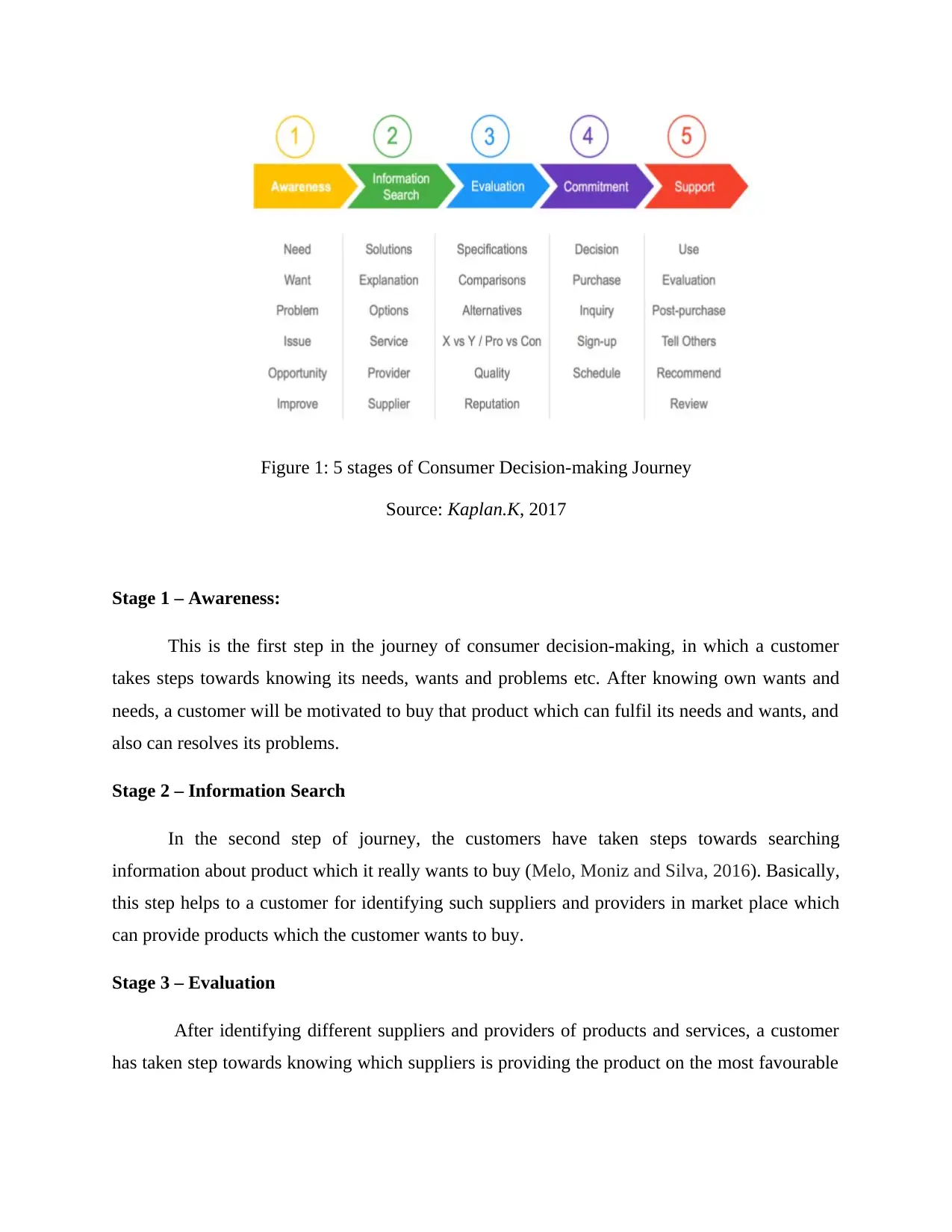
Figure 1: 5 stages of Consumer Decision-making Journey
Source: Kaplan.K, 2017
Stage 1 – Awareness:
This is the first step in the journey of consumer decision-making, in which a customer
takes steps towards knowing its needs, wants and problems etc. After knowing own wants and
needs, a customer will be motivated to buy that product which can fulfil its needs and wants, and
also can resolves its problems.
Stage 2 – Information Search
In the second step of journey, the customers have taken steps towards searching
information about product which it really wants to buy (Melo, Moniz and Silva, 2016). Basically,
this step helps to a customer for identifying such suppliers and providers in market place which
can provide products which the customer wants to buy.
Stage 3 – Evaluation
After identifying different suppliers and providers of products and services, a customer
has taken step towards knowing which suppliers is providing the product on the most favourable
Source: Kaplan.K, 2017
Stage 1 – Awareness:
This is the first step in the journey of consumer decision-making, in which a customer
takes steps towards knowing its needs, wants and problems etc. After knowing own wants and
needs, a customer will be motivated to buy that product which can fulfil its needs and wants, and
also can resolves its problems.
Stage 2 – Information Search
In the second step of journey, the customers have taken steps towards searching
information about product which it really wants to buy (Melo, Moniz and Silva, 2016). Basically,
this step helps to a customer for identifying such suppliers and providers in market place which
can provide products which the customer wants to buy.
Stage 3 – Evaluation
After identifying different suppliers and providers of products and services, a customer
has taken step towards knowing which suppliers is providing the product on the most favourable
Paraphrase This Document
Need a fresh take? Get an instant paraphrase of this document with our AI Paraphraser
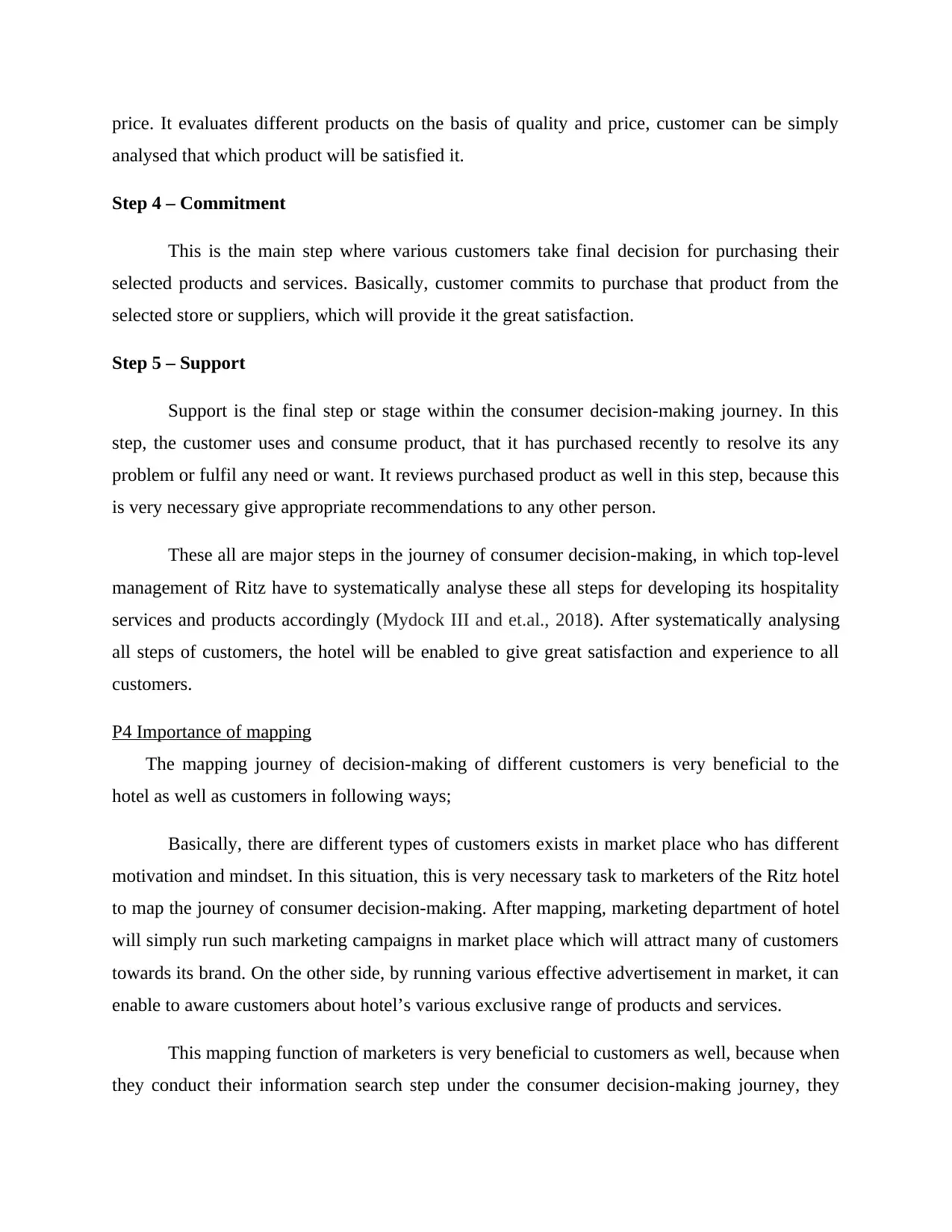
price. It evaluates different products on the basis of quality and price, customer can be simply
analysed that which product will be satisfied it.
Step 4 – Commitment
This is the main step where various customers take final decision for purchasing their
selected products and services. Basically, customer commits to purchase that product from the
selected store or suppliers, which will provide it the great satisfaction.
Step 5 – Support
Support is the final step or stage within the consumer decision-making journey. In this
step, the customer uses and consume product, that it has purchased recently to resolve its any
problem or fulfil any need or want. It reviews purchased product as well in this step, because this
is very necessary give appropriate recommendations to any other person.
These all are major steps in the journey of consumer decision-making, in which top-level
management of Ritz have to systematically analyse these all steps for developing its hospitality
services and products accordingly (Mydock III and et.al., 2018). After systematically analysing
all steps of customers, the hotel will be enabled to give great satisfaction and experience to all
customers.
P4 Importance of mapping
The mapping journey of decision-making of different customers is very beneficial to the
hotel as well as customers in following ways;
Basically, there are different types of customers exists in market place who has different
motivation and mindset. In this situation, this is very necessary task to marketers of the Ritz hotel
to map the journey of consumer decision-making. After mapping, marketing department of hotel
will simply run such marketing campaigns in market place which will attract many of customers
towards its brand. On the other side, by running various effective advertisement in market, it can
enable to aware customers about hotel’s various exclusive range of products and services.
This mapping function of marketers is very beneficial to customers as well, because when
they conduct their information search step under the consumer decision-making journey, they
analysed that which product will be satisfied it.
Step 4 – Commitment
This is the main step where various customers take final decision for purchasing their
selected products and services. Basically, customer commits to purchase that product from the
selected store or suppliers, which will provide it the great satisfaction.
Step 5 – Support
Support is the final step or stage within the consumer decision-making journey. In this
step, the customer uses and consume product, that it has purchased recently to resolve its any
problem or fulfil any need or want. It reviews purchased product as well in this step, because this
is very necessary give appropriate recommendations to any other person.
These all are major steps in the journey of consumer decision-making, in which top-level
management of Ritz have to systematically analyse these all steps for developing its hospitality
services and products accordingly (Mydock III and et.al., 2018). After systematically analysing
all steps of customers, the hotel will be enabled to give great satisfaction and experience to all
customers.
P4 Importance of mapping
The mapping journey of decision-making of different customers is very beneficial to the
hotel as well as customers in following ways;
Basically, there are different types of customers exists in market place who has different
motivation and mindset. In this situation, this is very necessary task to marketers of the Ritz hotel
to map the journey of consumer decision-making. After mapping, marketing department of hotel
will simply run such marketing campaigns in market place which will attract many of customers
towards its brand. On the other side, by running various effective advertisement in market, it can
enable to aware customers about hotel’s various exclusive range of products and services.
This mapping function of marketers is very beneficial to customers as well, because when
they conduct their information search step under the consumer decision-making journey, they
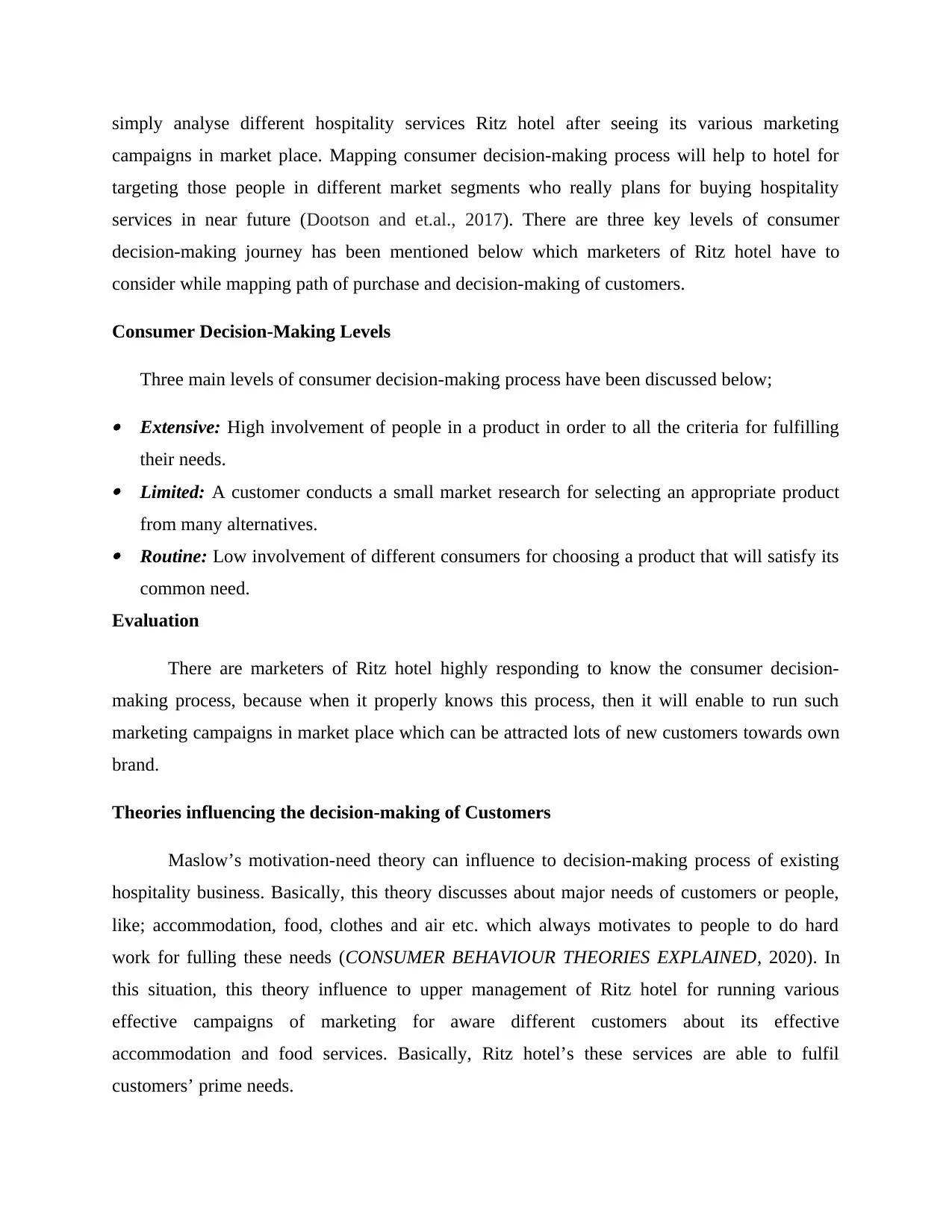
simply analyse different hospitality services Ritz hotel after seeing its various marketing
campaigns in market place. Mapping consumer decision-making process will help to hotel for
targeting those people in different market segments who really plans for buying hospitality
services in near future (Dootson and et.al., 2017). There are three key levels of consumer
decision-making journey has been mentioned below which marketers of Ritz hotel have to
consider while mapping path of purchase and decision-making of customers.
Consumer Decision-Making Levels
Three main levels of consumer decision-making process have been discussed below;
Extensive: High involvement of people in a product in order to all the criteria for fulfilling
their needs. Limited: A customer conducts a small market research for selecting an appropriate product
from many alternatives. Routine: Low involvement of different consumers for choosing a product that will satisfy its
common need.
Evaluation
There are marketers of Ritz hotel highly responding to know the consumer decision-
making process, because when it properly knows this process, then it will enable to run such
marketing campaigns in market place which can be attracted lots of new customers towards own
brand.
Theories influencing the decision-making of Customers
Maslow’s motivation-need theory can influence to decision-making process of existing
hospitality business. Basically, this theory discusses about major needs of customers or people,
like; accommodation, food, clothes and air etc. which always motivates to people to do hard
work for fulling these needs (CONSUMER BEHAVIOUR THEORIES EXPLAINED, 2020). In
this situation, this theory influence to upper management of Ritz hotel for running various
effective campaigns of marketing for aware different customers about its effective
accommodation and food services. Basically, Ritz hotel’s these services are able to fulfil
customers’ prime needs.
campaigns in market place. Mapping consumer decision-making process will help to hotel for
targeting those people in different market segments who really plans for buying hospitality
services in near future (Dootson and et.al., 2017). There are three key levels of consumer
decision-making journey has been mentioned below which marketers of Ritz hotel have to
consider while mapping path of purchase and decision-making of customers.
Consumer Decision-Making Levels
Three main levels of consumer decision-making process have been discussed below;
Extensive: High involvement of people in a product in order to all the criteria for fulfilling
their needs. Limited: A customer conducts a small market research for selecting an appropriate product
from many alternatives. Routine: Low involvement of different consumers for choosing a product that will satisfy its
common need.
Evaluation
There are marketers of Ritz hotel highly responding to know the consumer decision-
making process, because when it properly knows this process, then it will enable to run such
marketing campaigns in market place which can be attracted lots of new customers towards own
brand.
Theories influencing the decision-making of Customers
Maslow’s motivation-need theory can influence to decision-making process of existing
hospitality business. Basically, this theory discusses about major needs of customers or people,
like; accommodation, food, clothes and air etc. which always motivates to people to do hard
work for fulling these needs (CONSUMER BEHAVIOUR THEORIES EXPLAINED, 2020). In
this situation, this theory influence to upper management of Ritz hotel for running various
effective campaigns of marketing for aware different customers about its effective
accommodation and food services. Basically, Ritz hotel’s these services are able to fulfil
customers’ prime needs.
⊘ This is a preview!⊘
Do you want full access?
Subscribe today to unlock all pages.

Trusted by 1+ million students worldwide
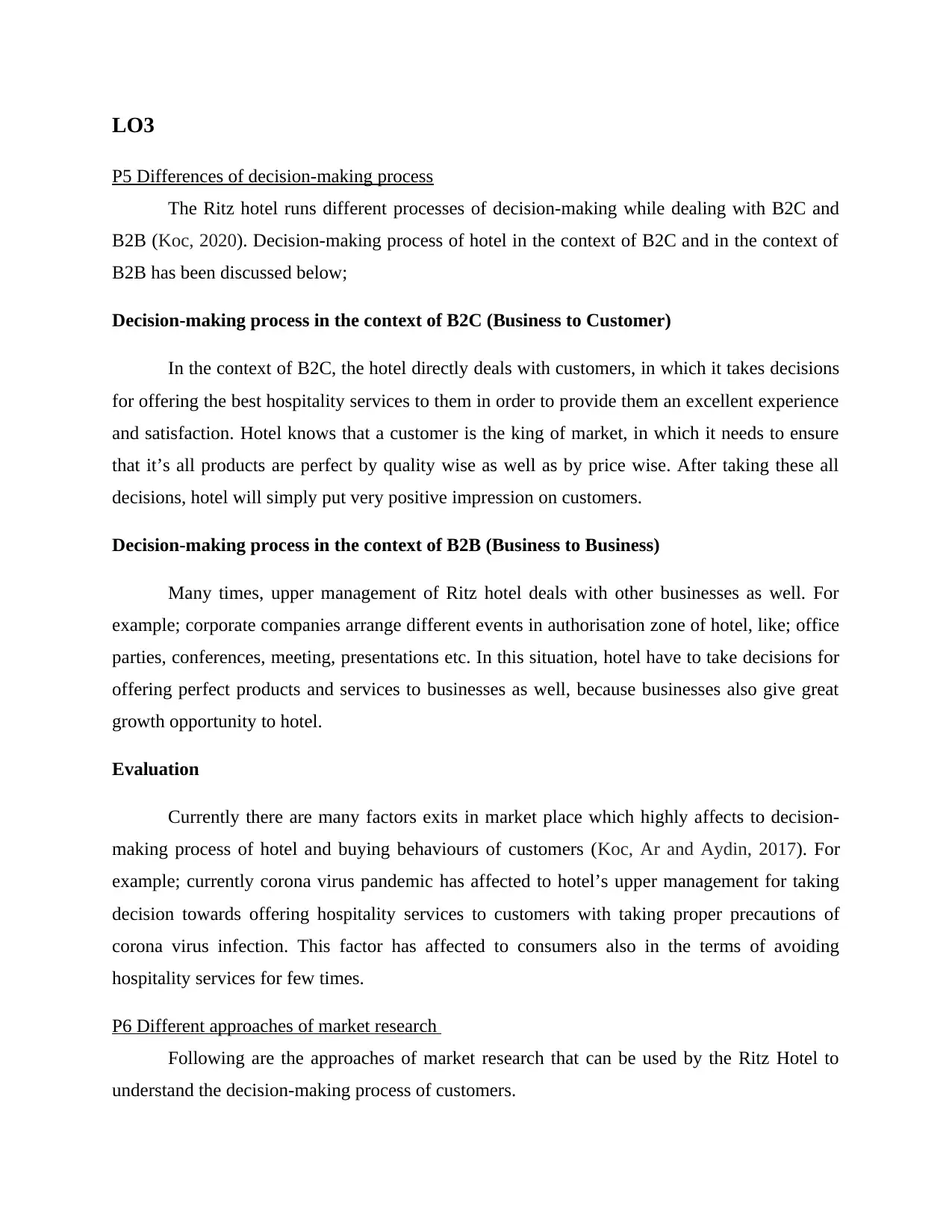
LO3
P5 Differences of decision-making process
The Ritz hotel runs different processes of decision-making while dealing with B2C and
B2B (Koc, 2020). Decision-making process of hotel in the context of B2C and in the context of
B2B has been discussed below;
Decision-making process in the context of B2C (Business to Customer)
In the context of B2C, the hotel directly deals with customers, in which it takes decisions
for offering the best hospitality services to them in order to provide them an excellent experience
and satisfaction. Hotel knows that a customer is the king of market, in which it needs to ensure
that it’s all products are perfect by quality wise as well as by price wise. After taking these all
decisions, hotel will simply put very positive impression on customers.
Decision-making process in the context of B2B (Business to Business)
Many times, upper management of Ritz hotel deals with other businesses as well. For
example; corporate companies arrange different events in authorisation zone of hotel, like; office
parties, conferences, meeting, presentations etc. In this situation, hotel have to take decisions for
offering perfect products and services to businesses as well, because businesses also give great
growth opportunity to hotel.
Evaluation
Currently there are many factors exits in market place which highly affects to decision-
making process of hotel and buying behaviours of customers (Koc, Ar and Aydin, 2017). For
example; currently corona virus pandemic has affected to hotel’s upper management for taking
decision towards offering hospitality services to customers with taking proper precautions of
corona virus infection. This factor has affected to consumers also in the terms of avoiding
hospitality services for few times.
P6 Different approaches of market research
Following are the approaches of market research that can be used by the Ritz Hotel to
understand the decision-making process of customers.
P5 Differences of decision-making process
The Ritz hotel runs different processes of decision-making while dealing with B2C and
B2B (Koc, 2020). Decision-making process of hotel in the context of B2C and in the context of
B2B has been discussed below;
Decision-making process in the context of B2C (Business to Customer)
In the context of B2C, the hotel directly deals with customers, in which it takes decisions
for offering the best hospitality services to them in order to provide them an excellent experience
and satisfaction. Hotel knows that a customer is the king of market, in which it needs to ensure
that it’s all products are perfect by quality wise as well as by price wise. After taking these all
decisions, hotel will simply put very positive impression on customers.
Decision-making process in the context of B2B (Business to Business)
Many times, upper management of Ritz hotel deals with other businesses as well. For
example; corporate companies arrange different events in authorisation zone of hotel, like; office
parties, conferences, meeting, presentations etc. In this situation, hotel have to take decisions for
offering perfect products and services to businesses as well, because businesses also give great
growth opportunity to hotel.
Evaluation
Currently there are many factors exits in market place which highly affects to decision-
making process of hotel and buying behaviours of customers (Koc, Ar and Aydin, 2017). For
example; currently corona virus pandemic has affected to hotel’s upper management for taking
decision towards offering hospitality services to customers with taking proper precautions of
corona virus infection. This factor has affected to consumers also in the terms of avoiding
hospitality services for few times.
P6 Different approaches of market research
Following are the approaches of market research that can be used by the Ritz Hotel to
understand the decision-making process of customers.
Paraphrase This Document
Need a fresh take? Get an instant paraphrase of this document with our AI Paraphraser
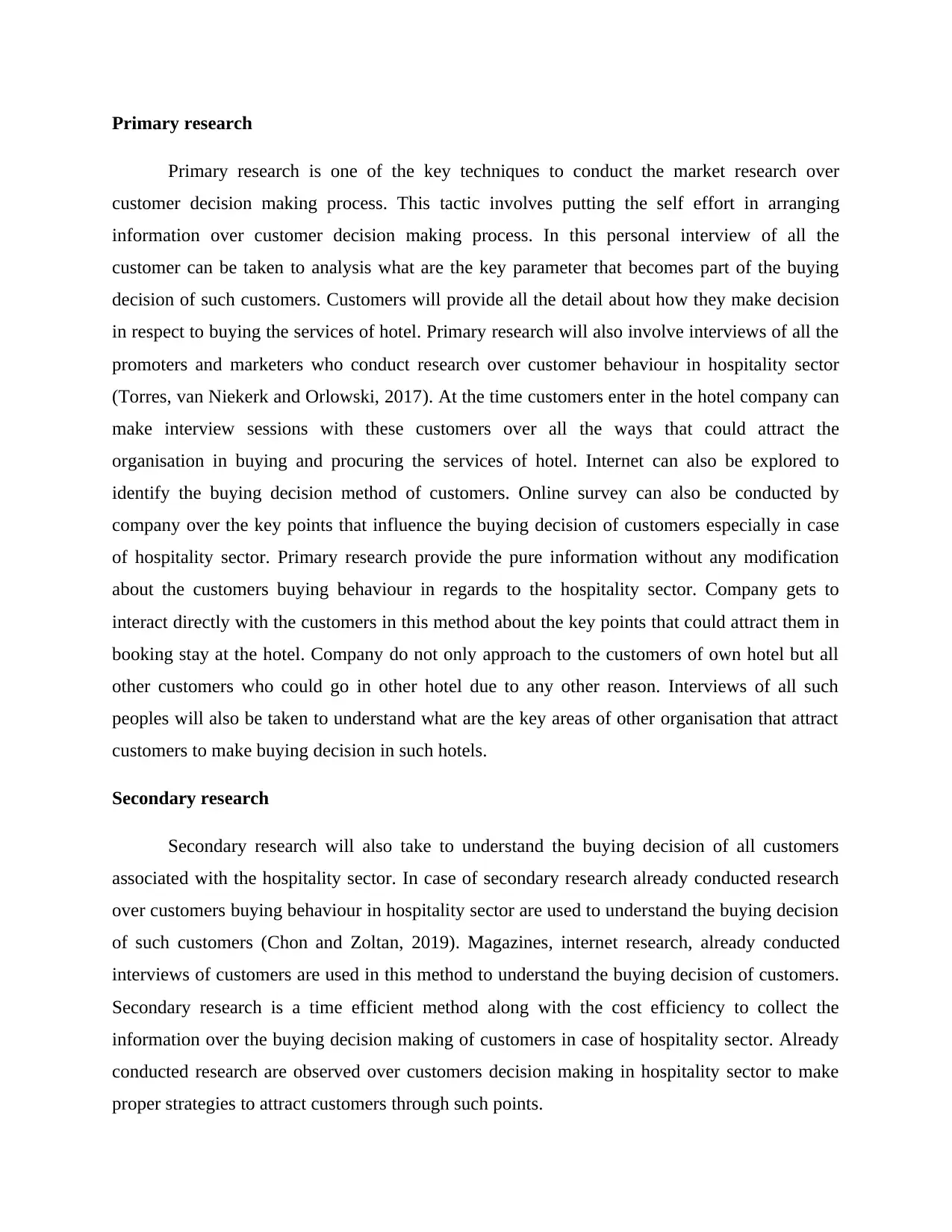
Primary research
Primary research is one of the key techniques to conduct the market research over
customer decision making process. This tactic involves putting the self effort in arranging
information over customer decision making process. In this personal interview of all the
customer can be taken to analysis what are the key parameter that becomes part of the buying
decision of such customers. Customers will provide all the detail about how they make decision
in respect to buying the services of hotel. Primary research will also involve interviews of all the
promoters and marketers who conduct research over customer behaviour in hospitality sector
(Torres, van Niekerk and Orlowski, 2017). At the time customers enter in the hotel company can
make interview sessions with these customers over all the ways that could attract the
organisation in buying and procuring the services of hotel. Internet can also be explored to
identify the buying decision method of customers. Online survey can also be conducted by
company over the key points that influence the buying decision of customers especially in case
of hospitality sector. Primary research provide the pure information without any modification
about the customers buying behaviour in regards to the hospitality sector. Company gets to
interact directly with the customers in this method about the key points that could attract them in
booking stay at the hotel. Company do not only approach to the customers of own hotel but all
other customers who could go in other hotel due to any other reason. Interviews of all such
peoples will also be taken to understand what are the key areas of other organisation that attract
customers to make buying decision in such hotels.
Secondary research
Secondary research will also take to understand the buying decision of all customers
associated with the hospitality sector. In case of secondary research already conducted research
over customers buying behaviour in hospitality sector are used to understand the buying decision
of such customers (Chon and Zoltan, 2019). Magazines, internet research, already conducted
interviews of customers are used in this method to understand the buying decision of customers.
Secondary research is a time efficient method along with the cost efficiency to collect the
information over the buying decision making of customers in case of hospitality sector. Already
conducted research are observed over customers decision making in hospitality sector to make
proper strategies to attract customers through such points.
Primary research is one of the key techniques to conduct the market research over
customer decision making process. This tactic involves putting the self effort in arranging
information over customer decision making process. In this personal interview of all the
customer can be taken to analysis what are the key parameter that becomes part of the buying
decision of such customers. Customers will provide all the detail about how they make decision
in respect to buying the services of hotel. Primary research will also involve interviews of all the
promoters and marketers who conduct research over customer behaviour in hospitality sector
(Torres, van Niekerk and Orlowski, 2017). At the time customers enter in the hotel company can
make interview sessions with these customers over all the ways that could attract the
organisation in buying and procuring the services of hotel. Internet can also be explored to
identify the buying decision method of customers. Online survey can also be conducted by
company over the key points that influence the buying decision of customers especially in case
of hospitality sector. Primary research provide the pure information without any modification
about the customers buying behaviour in regards to the hospitality sector. Company gets to
interact directly with the customers in this method about the key points that could attract them in
booking stay at the hotel. Company do not only approach to the customers of own hotel but all
other customers who could go in other hotel due to any other reason. Interviews of all such
peoples will also be taken to understand what are the key areas of other organisation that attract
customers to make buying decision in such hotels.
Secondary research
Secondary research will also take to understand the buying decision of all customers
associated with the hospitality sector. In case of secondary research already conducted research
over customers buying behaviour in hospitality sector are used to understand the buying decision
of such customers (Chon and Zoltan, 2019). Magazines, internet research, already conducted
interviews of customers are used in this method to understand the buying decision of customers.
Secondary research is a time efficient method along with the cost efficiency to collect the
information over the buying decision making of customers in case of hospitality sector. Already
conducted research are observed over customers decision making in hospitality sector to make
proper strategies to attract customers through such points.
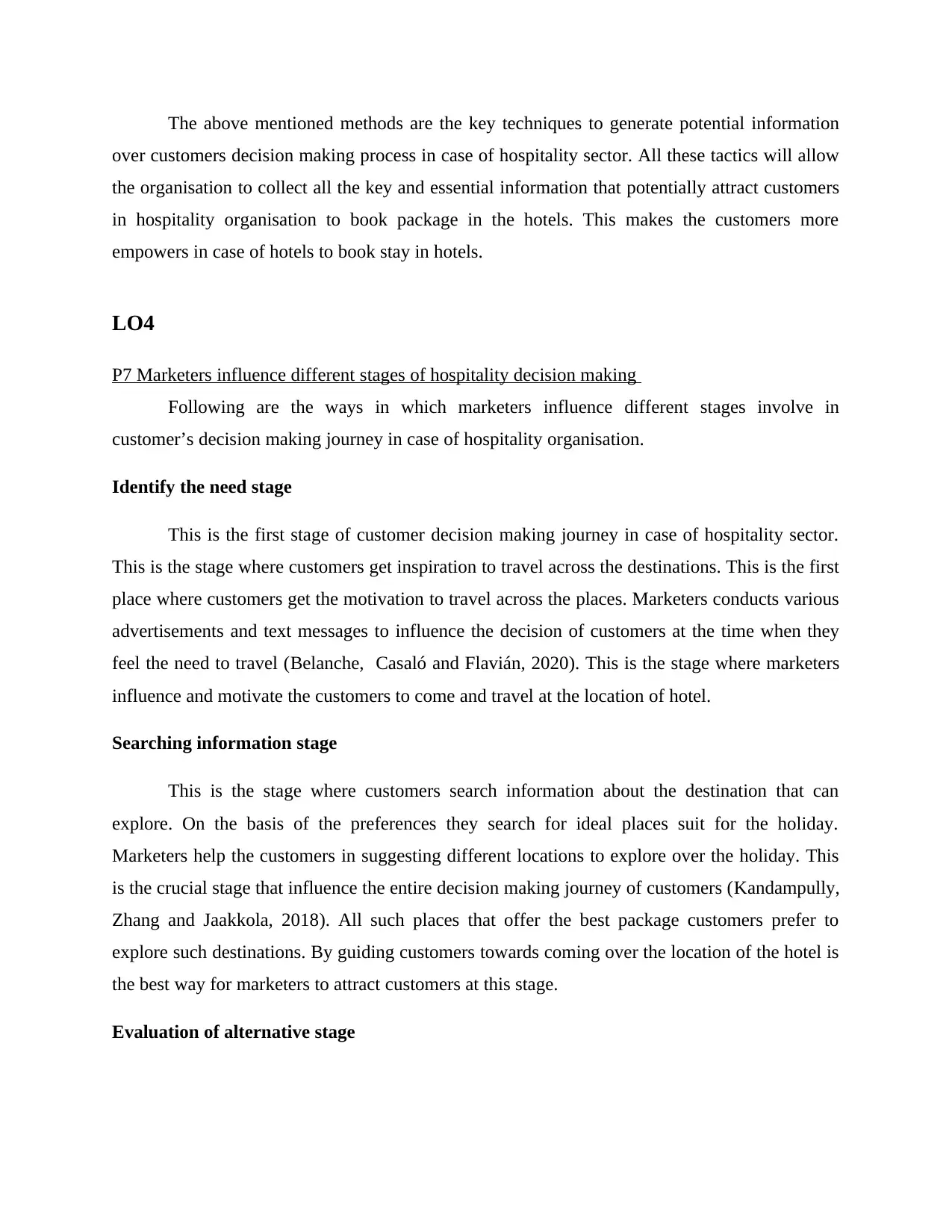
The above mentioned methods are the key techniques to generate potential information
over customers decision making process in case of hospitality sector. All these tactics will allow
the organisation to collect all the key and essential information that potentially attract customers
in hospitality organisation to book package in the hotels. This makes the customers more
empowers in case of hotels to book stay in hotels.
LO4
P7 Marketers influence different stages of hospitality decision making
Following are the ways in which marketers influence different stages involve in
customer’s decision making journey in case of hospitality organisation.
Identify the need stage
This is the first stage of customer decision making journey in case of hospitality sector.
This is the stage where customers get inspiration to travel across the destinations. This is the first
place where customers get the motivation to travel across the places. Marketers conducts various
advertisements and text messages to influence the decision of customers at the time when they
feel the need to travel (Belanche, Casaló and Flavián, 2020). This is the stage where marketers
influence and motivate the customers to come and travel at the location of hotel.
Searching information stage
This is the stage where customers search information about the destination that can
explore. On the basis of the preferences they search for ideal places suit for the holiday.
Marketers help the customers in suggesting different locations to explore over the holiday. This
is the crucial stage that influence the entire decision making journey of customers (Kandampully,
Zhang and Jaakkola, 2018). All such places that offer the best package customers prefer to
explore such destinations. By guiding customers towards coming over the location of the hotel is
the best way for marketers to attract customers at this stage.
Evaluation of alternative stage
over customers decision making process in case of hospitality sector. All these tactics will allow
the organisation to collect all the key and essential information that potentially attract customers
in hospitality organisation to book package in the hotels. This makes the customers more
empowers in case of hotels to book stay in hotels.
LO4
P7 Marketers influence different stages of hospitality decision making
Following are the ways in which marketers influence different stages involve in
customer’s decision making journey in case of hospitality organisation.
Identify the need stage
This is the first stage of customer decision making journey in case of hospitality sector.
This is the stage where customers get inspiration to travel across the destinations. This is the first
place where customers get the motivation to travel across the places. Marketers conducts various
advertisements and text messages to influence the decision of customers at the time when they
feel the need to travel (Belanche, Casaló and Flavián, 2020). This is the stage where marketers
influence and motivate the customers to come and travel at the location of hotel.
Searching information stage
This is the stage where customers search information about the destination that can
explore. On the basis of the preferences they search for ideal places suit for the holiday.
Marketers help the customers in suggesting different locations to explore over the holiday. This
is the crucial stage that influence the entire decision making journey of customers (Kandampully,
Zhang and Jaakkola, 2018). All such places that offer the best package customers prefer to
explore such destinations. By guiding customers towards coming over the location of the hotel is
the best way for marketers to attract customers at this stage.
Evaluation of alternative stage
⊘ This is a preview!⊘
Do you want full access?
Subscribe today to unlock all pages.

Trusted by 1+ million students worldwide
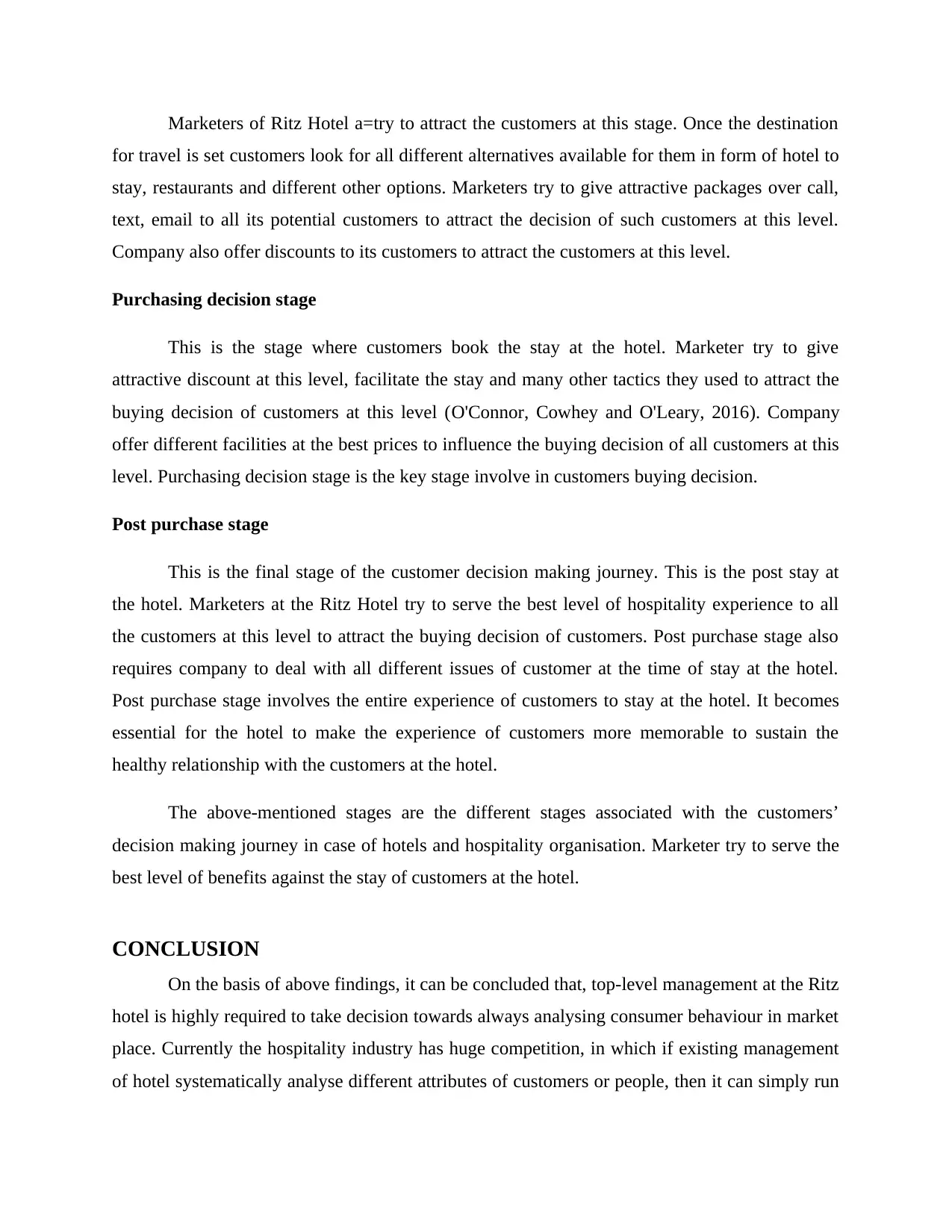
Marketers of Ritz Hotel a=try to attract the customers at this stage. Once the destination
for travel is set customers look for all different alternatives available for them in form of hotel to
stay, restaurants and different other options. Marketers try to give attractive packages over call,
text, email to all its potential customers to attract the decision of such customers at this level.
Company also offer discounts to its customers to attract the customers at this level.
Purchasing decision stage
This is the stage where customers book the stay at the hotel. Marketer try to give
attractive discount at this level, facilitate the stay and many other tactics they used to attract the
buying decision of customers at this level (O'Connor, Cowhey and O'Leary, 2016). Company
offer different facilities at the best prices to influence the buying decision of all customers at this
level. Purchasing decision stage is the key stage involve in customers buying decision.
Post purchase stage
This is the final stage of the customer decision making journey. This is the post stay at
the hotel. Marketers at the Ritz Hotel try to serve the best level of hospitality experience to all
the customers at this level to attract the buying decision of customers. Post purchase stage also
requires company to deal with all different issues of customer at the time of stay at the hotel.
Post purchase stage involves the entire experience of customers to stay at the hotel. It becomes
essential for the hotel to make the experience of customers more memorable to sustain the
healthy relationship with the customers at the hotel.
The above-mentioned stages are the different stages associated with the customers’
decision making journey in case of hotels and hospitality organisation. Marketer try to serve the
best level of benefits against the stay of customers at the hotel.
CONCLUSION
On the basis of above findings, it can be concluded that, top-level management at the Ritz
hotel is highly required to take decision towards always analysing consumer behaviour in market
place. Currently the hospitality industry has huge competition, in which if existing management
of hotel systematically analyse different attributes of customers or people, then it can simply run
for travel is set customers look for all different alternatives available for them in form of hotel to
stay, restaurants and different other options. Marketers try to give attractive packages over call,
text, email to all its potential customers to attract the decision of such customers at this level.
Company also offer discounts to its customers to attract the customers at this level.
Purchasing decision stage
This is the stage where customers book the stay at the hotel. Marketer try to give
attractive discount at this level, facilitate the stay and many other tactics they used to attract the
buying decision of customers at this level (O'Connor, Cowhey and O'Leary, 2016). Company
offer different facilities at the best prices to influence the buying decision of all customers at this
level. Purchasing decision stage is the key stage involve in customers buying decision.
Post purchase stage
This is the final stage of the customer decision making journey. This is the post stay at
the hotel. Marketers at the Ritz Hotel try to serve the best level of hospitality experience to all
the customers at this level to attract the buying decision of customers. Post purchase stage also
requires company to deal with all different issues of customer at the time of stay at the hotel.
Post purchase stage involves the entire experience of customers to stay at the hotel. It becomes
essential for the hotel to make the experience of customers more memorable to sustain the
healthy relationship with the customers at the hotel.
The above-mentioned stages are the different stages associated with the customers’
decision making journey in case of hotels and hospitality organisation. Marketer try to serve the
best level of benefits against the stay of customers at the hotel.
CONCLUSION
On the basis of above findings, it can be concluded that, top-level management at the Ritz
hotel is highly required to take decision towards always analysing consumer behaviour in market
place. Currently the hospitality industry has huge competition, in which if existing management
of hotel systematically analyse different attributes of customers or people, then it can simply run
Paraphrase This Document
Need a fresh take? Get an instant paraphrase of this document with our AI Paraphraser
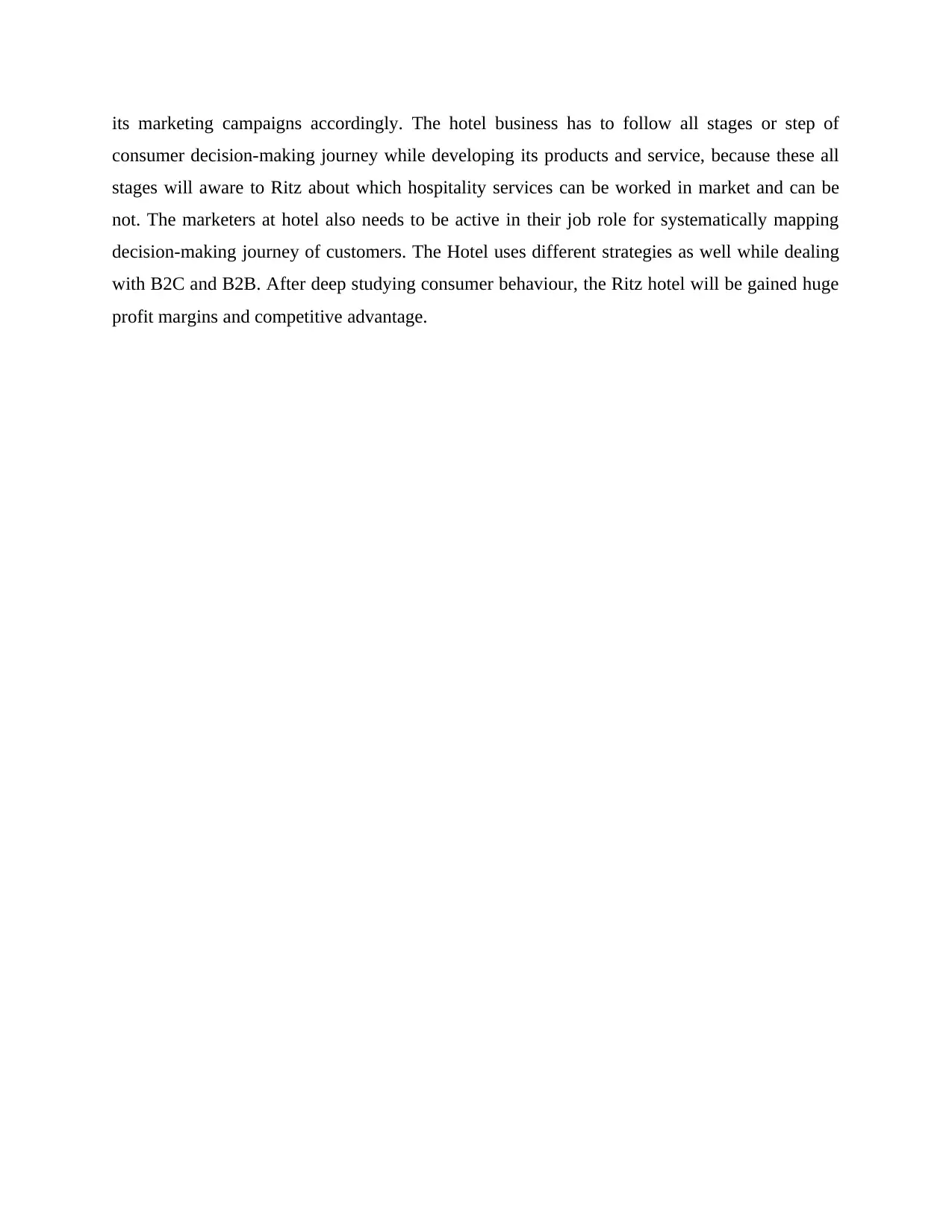
its marketing campaigns accordingly. The hotel business has to follow all stages or step of
consumer decision-making journey while developing its products and service, because these all
stages will aware to Ritz about which hospitality services can be worked in market and can be
not. The marketers at hotel also needs to be active in their job role for systematically mapping
decision-making journey of customers. The Hotel uses different strategies as well while dealing
with B2C and B2B. After deep studying consumer behaviour, the Ritz hotel will be gained huge
profit margins and competitive advantage.
consumer decision-making journey while developing its products and service, because these all
stages will aware to Ritz about which hospitality services can be worked in market and can be
not. The marketers at hotel also needs to be active in their job role for systematically mapping
decision-making journey of customers. The Hotel uses different strategies as well while dealing
with B2C and B2B. After deep studying consumer behaviour, the Ritz hotel will be gained huge
profit margins and competitive advantage.
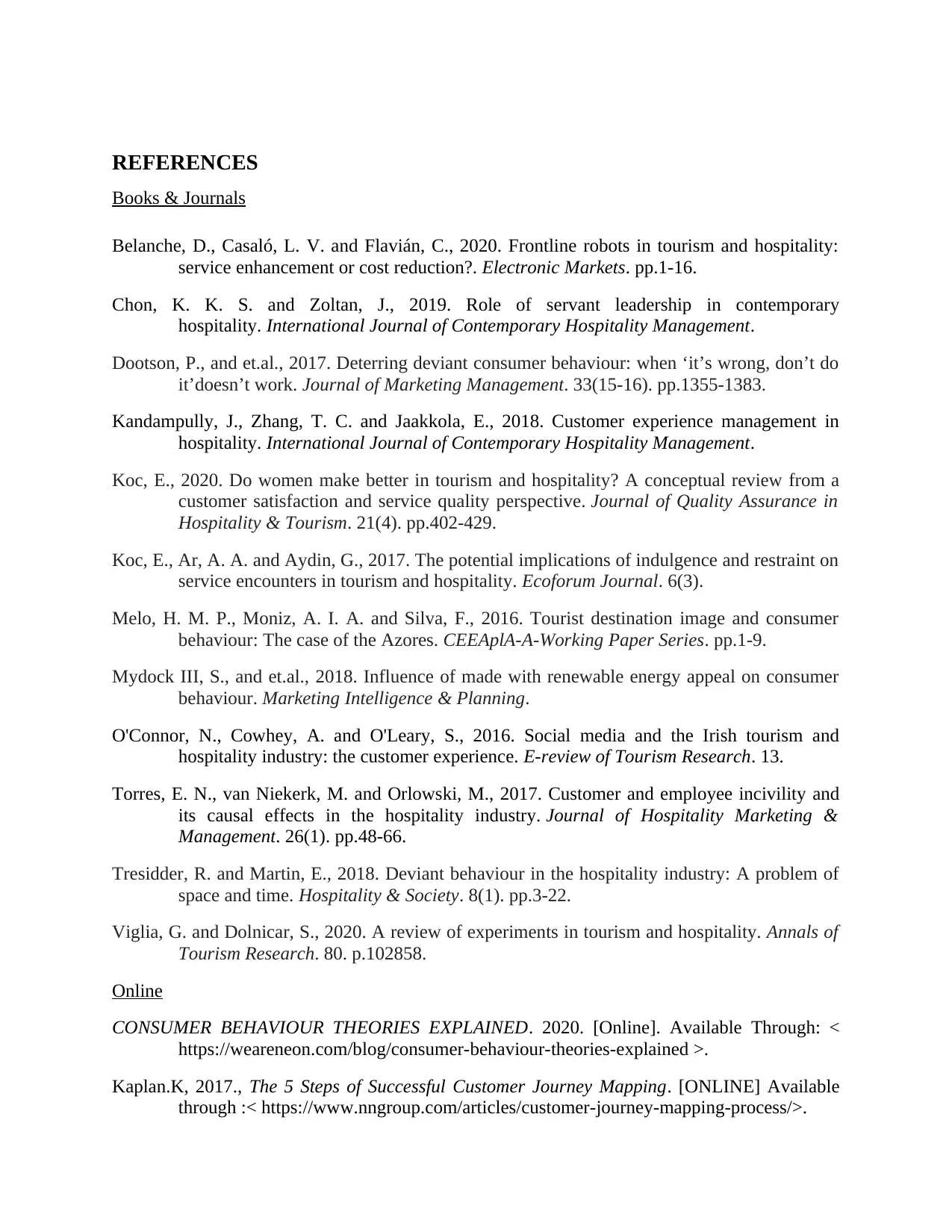
REFERENCES
Books & Journals
Belanche, D., Casaló, L. V. and Flavián, C., 2020. Frontline robots in tourism and hospitality:
service enhancement or cost reduction?. Electronic Markets. pp.1-16.
Chon, K. K. S. and Zoltan, J., 2019. Role of servant leadership in contemporary
hospitality. International Journal of Contemporary Hospitality Management.
Dootson, P., and et.al., 2017. Deterring deviant consumer behaviour: when ‘it’s wrong, don’t do
it’doesn’t work. Journal of Marketing Management. 33(15-16). pp.1355-1383.
Kandampully, J., Zhang, T. C. and Jaakkola, E., 2018. Customer experience management in
hospitality. International Journal of Contemporary Hospitality Management.
Koc, E., 2020. Do women make better in tourism and hospitality? A conceptual review from a
customer satisfaction and service quality perspective. Journal of Quality Assurance in
Hospitality & Tourism. 21(4). pp.402-429.
Koc, E., Ar, A. A. and Aydin, G., 2017. The potential implications of indulgence and restraint on
service encounters in tourism and hospitality. Ecoforum Journal. 6(3).
Melo, H. M. P., Moniz, A. I. A. and Silva, F., 2016. Tourist destination image and consumer
behaviour: The case of the Azores. CEEAplA-A-Working Paper Series. pp.1-9.
Mydock III, S., and et.al., 2018. Influence of made with renewable energy appeal on consumer
behaviour. Marketing Intelligence & Planning.
O'Connor, N., Cowhey, A. and O'Leary, S., 2016. Social media and the Irish tourism and
hospitality industry: the customer experience. E-review of Tourism Research. 13.
Torres, E. N., van Niekerk, M. and Orlowski, M., 2017. Customer and employee incivility and
its causal effects in the hospitality industry. Journal of Hospitality Marketing &
Management. 26(1). pp.48-66.
Tresidder, R. and Martin, E., 2018. Deviant behaviour in the hospitality industry: A problem of
space and time. Hospitality & Society. 8(1). pp.3-22.
Viglia, G. and Dolnicar, S., 2020. A review of experiments in tourism and hospitality. Annals of
Tourism Research. 80. p.102858.
Online
CONSUMER BEHAVIOUR THEORIES EXPLAINED. 2020. [Online]. Available Through: <
https://weareneon.com/blog/consumer-behaviour-theories-explained >.
Kaplan.K, 2017., The 5 Steps of Successful Customer Journey Mapping. [ONLINE] Available
through :< https://www.nngroup.com/articles/customer-journey-mapping-process/>.
Books & Journals
Belanche, D., Casaló, L. V. and Flavián, C., 2020. Frontline robots in tourism and hospitality:
service enhancement or cost reduction?. Electronic Markets. pp.1-16.
Chon, K. K. S. and Zoltan, J., 2019. Role of servant leadership in contemporary
hospitality. International Journal of Contemporary Hospitality Management.
Dootson, P., and et.al., 2017. Deterring deviant consumer behaviour: when ‘it’s wrong, don’t do
it’doesn’t work. Journal of Marketing Management. 33(15-16). pp.1355-1383.
Kandampully, J., Zhang, T. C. and Jaakkola, E., 2018. Customer experience management in
hospitality. International Journal of Contemporary Hospitality Management.
Koc, E., 2020. Do women make better in tourism and hospitality? A conceptual review from a
customer satisfaction and service quality perspective. Journal of Quality Assurance in
Hospitality & Tourism. 21(4). pp.402-429.
Koc, E., Ar, A. A. and Aydin, G., 2017. The potential implications of indulgence and restraint on
service encounters in tourism and hospitality. Ecoforum Journal. 6(3).
Melo, H. M. P., Moniz, A. I. A. and Silva, F., 2016. Tourist destination image and consumer
behaviour: The case of the Azores. CEEAplA-A-Working Paper Series. pp.1-9.
Mydock III, S., and et.al., 2018. Influence of made with renewable energy appeal on consumer
behaviour. Marketing Intelligence & Planning.
O'Connor, N., Cowhey, A. and O'Leary, S., 2016. Social media and the Irish tourism and
hospitality industry: the customer experience. E-review of Tourism Research. 13.
Torres, E. N., van Niekerk, M. and Orlowski, M., 2017. Customer and employee incivility and
its causal effects in the hospitality industry. Journal of Hospitality Marketing &
Management. 26(1). pp.48-66.
Tresidder, R. and Martin, E., 2018. Deviant behaviour in the hospitality industry: A problem of
space and time. Hospitality & Society. 8(1). pp.3-22.
Viglia, G. and Dolnicar, S., 2020. A review of experiments in tourism and hospitality. Annals of
Tourism Research. 80. p.102858.
Online
CONSUMER BEHAVIOUR THEORIES EXPLAINED. 2020. [Online]. Available Through: <
https://weareneon.com/blog/consumer-behaviour-theories-explained >.
Kaplan.K, 2017., The 5 Steps of Successful Customer Journey Mapping. [ONLINE] Available
through :< https://www.nngroup.com/articles/customer-journey-mapping-process/>.
⊘ This is a preview!⊘
Do you want full access?
Subscribe today to unlock all pages.

Trusted by 1+ million students worldwide
1 out of 13
Related Documents
Your All-in-One AI-Powered Toolkit for Academic Success.
+13062052269
info@desklib.com
Available 24*7 on WhatsApp / Email
![[object Object]](/_next/static/media/star-bottom.7253800d.svg)
Unlock your academic potential
Copyright © 2020–2025 A2Z Services. All Rights Reserved. Developed and managed by ZUCOL.




